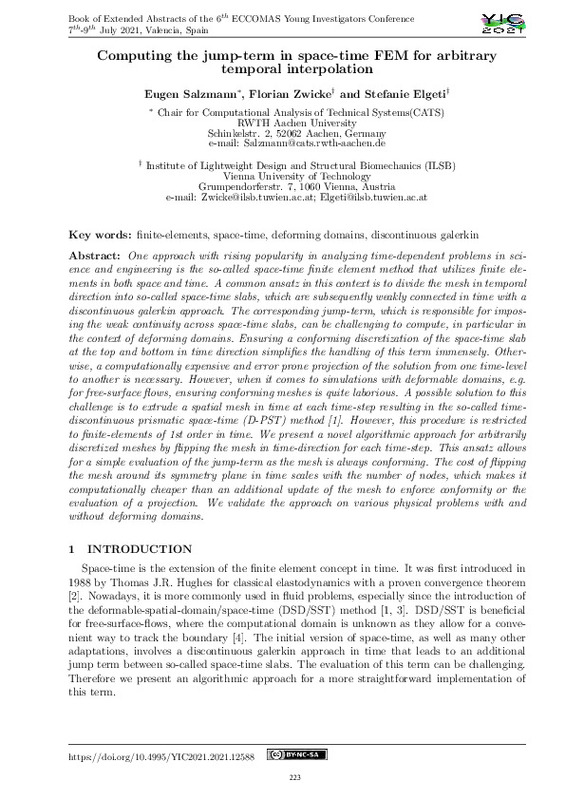JavaScript is disabled for your browser. Some features of this site may not work without it.
Buscar en RiuNet
Listar
Mi cuenta
Estadísticas
Ayuda RiuNet
Admin. UPV
Computing the jump-term in space-time FEM for arbitrary temporal interpolation
Mostrar el registro sencillo del ítem
Ficheros en el ítem
| dc.contributor.author | Salzmann, Eugen
|
es_ES |
| dc.contributor.author | Zwickey, Florian
|
es_ES |
| dc.contributor.author | Elgeti, Stefanie
|
es_ES |
| dc.date.accessioned | 2022-09-29T08:07:01Z | |
| dc.date.available | 2022-09-29T08:07:01Z | |
| dc.date.issued | 2022-05-11 | |
| dc.identifier.isbn | 9788490489697 | |
| dc.identifier.uri | http://hdl.handle.net/10251/186701 | |
| dc.description.abstract | [EN] One approach with rising popularity in analyzing time-dependent problems in scienceand engineering is the so-called space-time finite-element method that utilized finiteelementsin both space and time. A common ansatz in this context is to divide the meshin temporal direction into so-called space-time slabs, which are subsequently weaklyconnected in time with a Discontinuous Galerkin approach. The corresponding jumpterm,which is responsible for imposing the weak continuity across space-time slabs canbe challenging to compute, in particular in the context of deforming domains. Ensuringa conforming discretization of the space-time slab at the top and bottom in timedirection simplifies the handling of this term immensely. Otherwise, a computationallyexpensive and error prone projection of the solution from one time-level to another isnecessary. However, when it comes to simulations with deformable domains, e.g. forfree-surface flows, ensuring conforming meshes is quite laborious. A possible solutionto this challenge is to extrude a spatial mesh in time at each time-step resulting in theso-called time-discontinuous prismatic space-time (D-PST) method[1]. However, thisprocedure is restricted to finite-elements of 1st order in time.We present a novel algorithmic approach for arbitrarily discretized meshes by flippingthe mesh in time-direction for each time-step. This ansatz allows for a simple evaluationof the jump-term as the mesh is always conforming. The cost of flipping the mesharound its symmetry plane in time scales with the number of nodes, which makes itcomputationally cheaper than an additional update of the mesh to enforce conformity orthe evaluation of a projection. We validate the approach on various physical problemswith and without deforming domains. | es_ES |
| dc.format.extent | 9 | es_ES |
| dc.language | Inglés | es_ES |
| dc.publisher | Editorial Universitat Politècnica de València | es_ES |
| dc.relation.ispartof | Proceedings of the YIC 2021 - VI ECCOMAS Young Investigators Conference | |
| dc.rights | Reconocimiento - No comercial - Compartir igual (by-nc-sa) | es_ES |
| dc.subject | Finite-elements | es_ES |
| dc.subject | Space-time | es_ES |
| dc.subject | Deforming domains | es_ES |
| dc.subject | Discontinuous Galerkin | es_ES |
| dc.title | Computing the jump-term in space-time FEM for arbitrary temporal interpolation | es_ES |
| dc.type | Capítulo de libro | es_ES |
| dc.type | Comunicación en congreso | es_ES |
| dc.identifier.doi | 10.4995/YIC2021.2021.12588 | |
| dc.relation.projectID | info:eu-repo/grantAgreement/DFG//741%2F8-1 | es_ES |
| dc.rights.accessRights | Abierto | es_ES |
| dc.description.bibliographicCitation | Salzmann, E.; Zwickey, F.; Elgeti, S. (2022). Computing the jump-term in space-time FEM for arbitrary temporal interpolation. En Proceedings of the YIC 2021 - VI ECCOMAS Young Investigators Conference. Editorial Universitat Politècnica de València. 223-231. https://doi.org/10.4995/YIC2021.2021.12588 | es_ES |
| dc.description.accrualMethod | OCS | es_ES |
| dc.relation.conferencename | VI ECCOMAS Young Investigators Conference | es_ES |
| dc.relation.conferencedate | Julio 07-09, 2021 | es_ES |
| dc.relation.conferenceplace | Valencia, España | es_ES |
| dc.relation.publisherversion | http://ocs.editorial.upv.es/index.php/YIC/YIC2021/paper/view/12588 | es_ES |
| dc.description.upvformatpinicio | 223 | es_ES |
| dc.description.upvformatpfin | 231 | es_ES |
| dc.type.version | info:eu-repo/semantics/publishedVersion | es_ES |
| dc.relation.pasarela | OCS\12588 | es_ES |
| dc.contributor.funder | Deutsche Forschungsgemeinschaft | es_ES |








